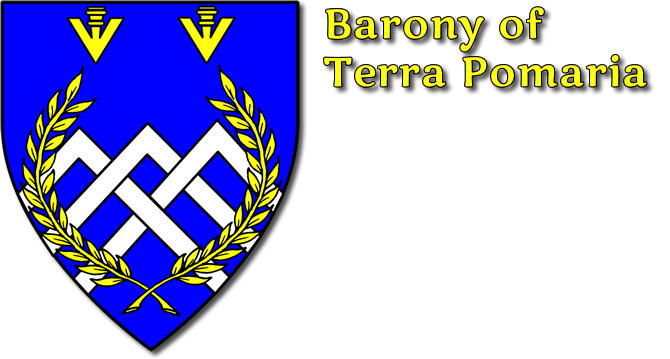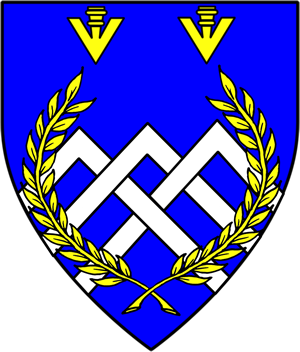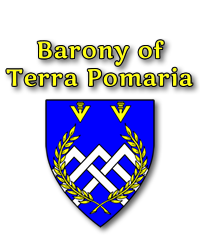19 Dec Feasts and Service
Then Serve It Forth…
By Lady Rosemary Willowwood de Ste. Anne
Beginnings are a bit hard, and new concentrations for this column are difficult to choose from. I have given the Barony three years of medieval recipes. I thought this year to give a bit better idea of how to serve and present the tasty things we cook. I will begin with at least one excerpt from the Book of Kervynge, which was designed to train pages in how to gracefully serve the foods the master cook prepared for the Crown. It should be noted that these were instructions for noblemen, not servants, because it was considered an honor to serve the monarch, and a king would not feel at all unusual to be served by his earls and barons, most of whom learned to provide graceful service as children.
“Feestes and servyce from Easter unto Whytsondaye”
From The Book of Kervynge
Treatise printed by Wynkyn de Worde (1513)
On Eester day & so forth to Pentecost after the Servynge of the table there shall be set brede trenchours and spones after the estymacyon of them that shall syt there and thus ye shall serve your soverayne laye trencours before hym, if he be a grete estate lay fyve trenchours & he be of lower degre foure trenchours & of an other degre thre trenchours, than cut brede for your soverayne after he know his condecyons where it be cutte in the myddes or pared or elles for to be cut in small peces.
Also ye must understonde how the merte shall be served before your soverayne & namely on Eester Daye after the governaunce & servyce of the countre where ye were borne. Fyrste on that daye ye shall serve a calfe loden and blessyd, and tthan soden egges with grene sauce and set them before the moost pryncypall estate, and that lorde because of his hyghe estate shall departe them all aboute hym, than serve potage as wortes Jowetes or browes with befe motton or vele, & capons that ben coloured with saffron and bake metes. And in the seconde course Jussell with mamony and rosted edovred, & pegyons with bake metes as tartes chewettes & fawnes & other after the dysposycyon of hte kokes.
And at soupertyme dyvers sauces of motton or vele in broche after the ordynaunce of the stewarde and than chekyns with bacon vele rost pegyons or lambe and pygges fete with vynegre & precely theron & a tansey fryed & other bake metes, ye shall understande this maner of servyce dureth to Pentecost save fysshe dayes.
Also take hede how ye shall araye these thynges before your soverayne, fyrst ye shall se there be grene sauces of sorellor of vynes that is holde of sauce for the fyrst course, and ye shall begyn to reyse the capon.
TRANSLATION: On Easter Day, and so forth to Pentecost, after the serving of the table there shall be set bread trenchers and spoons after the estimation of them that shall sit there, and thus you shall serve your sovereign: lay trenchers (see glossary) before him. If he be of great estate, lay five trenchers, and he be of lower degree, four trenchers, and if another degree, three trenchers. Then cut bread for your sovereign after you know his conditions, whether it be cut in the middle, or pared [Ed. comment: crust removed], or else to be cut in small pieces.
Also, you must understand how the meat shall be served before your sovereign, and especially on Easter Day, after the custom & service of the country where you were born. First on that day, you shall serve a calf, laden and blessed, and than boiled eggs with green sauce, and set them before the [lord of] highest estate, and that lord, because of his high estate, shall leave them all about him [Ed. comment: give them to other diners]. Then serve dishes [such] as vegetables, stews or soups with beef, mutton or veal, and capons that been colored with saffron, and baked foods. And in the second course, Jussell with mamony [specific recipes], and roasted glazed [foods] and pigeons, with baked foods [such] as tarts, chewettes & flawns (see glossary), and other [dishes] after the provision of the cooks.
And at supper time, various sauces of mutton or veal in crusts as the steward has provided, and than chickens with bacon, veal roasted, pigeons or lamb, and pig’s feet with vinegar & parsley thereon, & a tansy [Ed. comment: cheesecake made with tansy herb] fried, and other baked foods.
You shall maintain this manner of service through to Pentecost, except on fish days. Also take heed how you shall dress these things before your sovereign. First you shall see [that] there be green sauces of sorrel, of dishes that will hold sauce for the first course, and you shall begin to sauce the capon.
REALIZATION: No real realization is needed here. This presentation is designed to show what an exacting and demanding task it was to serve at a high table in the real middle ages. (No serve-yourself banquets here!) The last phrase of the recipe gives me an entry to next month’s column, because I will set out a list of the various terms and methods for saucing and serving various foods.
GLOSSARY:
Chewettes: Small pies of meat or fish
Flawns: A variety of custard pie
Trenchers: A loaf of manchet bread, trimmed of crust and sliced crosswise into “plates”. A trencher was not to be eaten, but was to protect the tablecloth from sauces from foods not designed to be eaten in a less pervious bowl. Trenchers were usually collected and given to the poor. To be called a “trencherman”, an eater of everything including the trencher, was not a compliment, but an insult. You were being called not only greedy, but irreligious.



